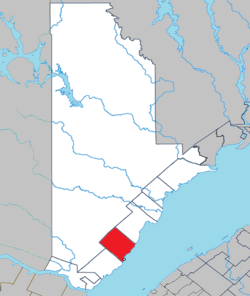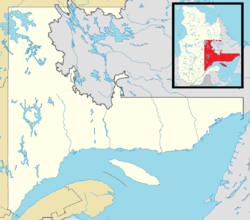Les Escoumins
Les Escoumins | |
|---|---|
 | |
 Location within La Haute-Côte-Nord RCM | |
| Coordinates: 48°21′05″N 69°24′27″W / 48.35139°N 69.40750°W[1][2] | |
| Country | Canada |
| Province | Quebec |
| Region | Côte-Nord |
| RCM | La Haute-Côte-Nord |
| Settled | 1825 |
| Constituted | 5 May 1863 |
| Government | |
| • Mayor | André Desrosiers |
| • Federal riding | Beauport—Côte-de-Beaupré—Île d'Orléans—Charlevoix |
| • Prov. riding | René-Lévesque |
| Area | |
| 284.79 km2 (109.96 sq mi) | |
| • Land | 265.89 km2 (102.66 sq mi) |
| • Urban | 1.61 km2 (0.62 sq mi) |
| Population (2021)[4] | |
| 1,794 | |
| • Density | 6.7/km2 (17/sq mi) |
| • Urban | 1,274 |
| • Urban density | 792.4/km2 (2,052/sq mi) |
| • Pop (2016-21) | |
| Time zone | UTC−05:00 (EST) |
| • Summer (DST) | UTC−04:00 (EDT) |
| Postal code(s) | |
| Area code(s) | 418 and 581 |
| Highways | |
| Website | escoumins |
Les Escoumins (French pronunciation: [lez‿ɛskumɛ̃]) is a municipality in La Haute-Côte-Nord Regional County Municipality in the Côte-Nord region of Quebec. It is located on the north shore of the maritime estuary of the St. Lawrence River.
Etymology
[edit]Its name has traditionally been recognized to come from the Innu-aimun iskomin, meaning "where there are many seeds" or "there are fruits or seeds", in turn from the roots isko or ishko ("as far as this/that") and min (red seeds, or wild berries in general). According to more recent theory, it could also be a variation of the Mi'kmaq term eskumunaak, meaning "lookout place". In addition, other sources say that the place is named Essipit in Innu-aimun, meaning "river of shells".[2]
Several spellings have been used over the centuries such as Uscamin, Les Escoumains, Essuie-Mains, L'Esquemin, Lesquemin, Leschemin (Champlain, 1629), L'Esquemain, and Lesquemain (1611 map of Champlain and other texts of 1626). The oldest reference to this name dates back to the map of Levasseur of 1601, that shows Escanimes; and to a contract of 1604 that included the rare spelling Esguenim.[2]
History
[edit]
The area is considered the cradle of the Côte-Nord Amerindian, who have lived there for thousands of years. The Innu (Montagnais) and Mi'kmaq frequented the area, particularly in the spring to gather berries that covered the rocks and adorned the mossy plains.[2] [6]
The first Europeans in the area were the Basques around the 1630s. In 1723, a cross was erected in honour of Our Dame of Bon-Désir, thereafter the place was also known as Bon-Desir. That same year the Mission of Saint-Marcellin was founded. But the first permanent European settler in Escoumins was Joseph Moreau, an employee of the Hudson's Bay Company, who arrived in 1825. It wasn't until 1845 that a real village began to form when many families from the south shore of the St. Lawrence River, especially from Trois-Pistoles, Rivière-Ouelle, Rimouski, and a group of Charlevoix settled there.[2]
In 1853, the local post office opened. The timber trade caused the village to grow rapidly when logs were floated down the Escoumins River from the cutting area to the Bay des Escoumins where they were loaded in barges. In 1863, the Municipality of Les Escoumains was formed. In the beginning of 1957, the spelling of the municipality's name was corrected to the current form.[2]
Services
[edit]Its economy is mostly based on the service sectors, especially education, health, and tourism. The village is currently the largest of the so-called "Secteur BEST" (i.e. the municipalities of Bergeronnes, Escoumins, Sacré-Coeur, Tadoussac). It is home to a hospital (The Centre de santé de la Haute-Côte-Nord, previously known as Hôpital St-Alexandre), an Indian reserve (Essipit, an Innu community), an FM radio station, CHME, is located within Essipit.
It is accessible via The Whale Route (Route 138).[7][8]
Whit 33 000 km of trails, The Federation of Snowmobile Clubs of Quebec and La Minganie Snowmobile Club, based in Les Escoumins,[9] offer detailed interactive maps on the different circuits and their points of services.
Sea side
[edit]On the north shore of the St. Lawrence River, surrounded by a multitude of bodies of water and vast expanses of sand, Les Escoumins is located approximately 40 km northeast of Tadoussac, between Bergeronnes and Saint-Paul-du -North.[10][2]
From its docks, it is even possible to observe marine mammals and even the largest living being on earth, the blue whale.
- Balaenoptera musculus. — Baleine bleue, Rorqual bleu. — (Blue whale).[11][12]
- Vessels and docks overview
Year-round service is available from Laurentian Pilotage Authority.[18] A ferry service runs between Les Escoumins and Trois-Pistoles.[17]
The Marine Environment Discovery Centre[19] is the main diving attraction in the region. It is also an interpretation centre for the fauna and flora of the Saguenay–St. Lawrence Marine Park, allowing you to discover the subarctic underwater ecosystem and hear the divers-biologists describe its particularities. (Seasonal activity)
Demographics
[edit]In the 2021 Canadian census conducted by Statistics Canada, Les Escoumins had a population of 1,794 living in 856 of its 983 total private dwellings, a change of -5.1% from its 2016 population of 1,891. With a land area of 265.89 km2 (102.66 sq mi), it had a population density of 6.7/km2 (17.5/sq mi) in 2021.[4]
The median age of the population in 2021 was 54.8 and 92% of the people were over 15.[4] At the same census 14.86% reported being Indigenous, almost evenly divided between Métis and First Nations.[4]
Languages spoken at the 2021 census, as a mother tongue were French (99.71%), English (0.29%), and other languages (0.29%).[4]
|
|
| |||||||||||||||||||||||||||||||||||||||||||||||||||||||||||||||
| Source: Statistics Canada[4][20][21][22][23][24][25] | |||||||||||||||||||||||||||||||||||||||||||||||||||||||||||||||||
Attractions
[edit]The Marine Environment Discovery Centre in Les Escoumins offers snorkelling and scuba diving, and observation areas for seals, seabirds, and whales, within the Saguenay–St. Lawrence Marine Park.[19]
Infrastructure
[edit]Transportation
[edit]It is accessible via The Whale Route (Route 138)[7][8] and by the sea.
Year-round service is available from Laurentian Pilotage Authority.[18] A ferry service runs between Les Escoumins and Trois-Pistoles.[17]
Media
[edit]CHME-FM is a radio station in the community.
See also
[edit]References
[edit]- ^ "Les Escoumins". Geographical Names Data Base. Natural Resources Canada.
- ^ a b c d e f g "Les Escoumins". Quebec Gouvernement (in French). Commission de Toponymie Quebec. 6 November 1986. Retrieved 27 April 2024.
The possibility of watching blue whales or fishing for cod attract many holidaymakers in search of sun and sea bathing.
- ^ a b "Les Escoumins (95025)". Répertoire des municipalités (in French). Government of Quebec. 26 March 2024. Retrieved 27 April 2024.
This gentilé is an official form, i.e. it has been the subject of a resolution of the municipal council.
- ^ a b c d e f g "Les Escoumins, Municipalité (MÉ) Census Profile, 2021 Census of Population". Statistics Canada. 1 February 2023. Retrieved 6 May 2024.
- ^ a b "Les Escoumins [Population centre] Census Profile, 2021 Census of Population". Statistics Canada. 15 November 2023. Retrieved 4 July 2024.
- ^ "Les Escoumins". Municipalité des Escoumins. 2024. Retrieved 9 May 2024.
Heir to the forest and the sea, the village of Les Escoumins invites you to the daily celebration of the marriage between the salt waters of the St. Lawrence River and the fresh waters of the forested hinterland
- ^ a b "Network of observation sites along the Whale Route (Route 138)" (PDF). 21 May 2010. p. 12. Retrieved 11 May 2024.
Whale-watching sites for everyone
- ^ a b "Whales of the St. Lawrence river". Whales Online. 2024. Retrieved 18 April 2024.
The estuary is home to belugas all year round. In summer, the estuary also hosts rorquals and other species of toothed whales that benefit from the abundance of krill, capelin and other small fish.
- ^ "La Minganie Snowmobile Club". Côte-Nord entre nature et démesure. 2024. Retrieved 15 May 2024.
In order to preserve our magnificent North Shore in its wild state, we invite you to adopt the principles of the Leave No Trace code of ethics.
- ^ "Répertoire des entités géopolitiques: Sault-au-Mouton (village) 1.1.1947 - 28.5.1997". www.mairesduquebec.com. Institut généalogique Drouin. Retrieved 3 July 2024.
- ^ "Come see the whales". Côte-Nord, between nature and excess. North Shore Tourism. 2024. Retrieved 4 June 2024.
The tide, the underwater relief and the currents generate phenomenal concentrations of fish and plankton. No wonder the St. Lawrence is one of the best places in the world for whale watching: it's a real open-air buffet!
- ^ "Blue whale (WWF)". World Wildlife Fund. 2024. Retrieved 28 July 2024.
The blue whale is the largest animal on the planet, weighing as much as 200 tons (approximately 33 elephants).
- ^ "Commercial fisheries licensing policy for Eastern Canada". Fisheries and Oceans Canada. 2024. Retrieved 12 May 2024.
The Licensing Policy is an integral part of a number of federal government initiatives to restructure the commercial fisheries and lay the foundation for a fishery that is environmentally sustainable and economically viable.
- ^ "Anse aux Basques". Quebec Gouvernement (in French). Commission de Toponymie Quebec. 5 December 1968. Retrieved 9 May 2024.
The pilot station of the Corporation des pilotes du Bas-Saint-Laurent occupies the northern part of the cove, a 61-metre-long wharf that allows boarding the pilot boat.
- ^ Antoine Blondain (2023). "Marine Transportation On The St. Lawrence River". Corporation of St.Lawrence Central Pilots. Retrieved 29 July 2024.
an estimated 8,500 maritime pilots from 55 countries are members of the International Maritime Pilots Association. Of these, 440 are Canadian and belong to the Canadian Marine Pilots' Association (CMPA)
- ^ Corporation des pilotes du Bas Saint-Laurent. "Naviguer sur le Saint-Laurent". Retrieved 8 May 2024.
La navigation sur le fleuve Saint-Laurent est l'une des plus périlleuses au monde.
- ^ a b c "Traverse Trois-Pistoles - Les Escoumins". 2024. Retrieved 13 May 2024.
It is recommends that you book your departure date and time in advance.
- ^ a b "Marine Environment Discovery Centre". 2024. Retrieved 12 May 2024.
Discover the underwater world of the Saguenay–St. Lawrence Marine Park from starfish to the largest marine mammals.
- ^ "96 Census: A National Overview - Population and Dwelling Counts" (PDF). Statistics Canada. April 1997. Retrieved 6 May 2024.
- ^ "Population and Dwelling Counts, for Canada, Provinces and Territories, and Census Subdivisions (Municipalities), 2001 and 1996 Censuses - 100% Data (Quebec)". Statistics Canada. 15 August 2012. p. 21. Retrieved 6 May 2024.
- ^ "Population and dwelling counts, for Canada, provinces and territories, and census subdivisions (municipalities), 2006 and 2001 censuses - 100% data (Quebec)". Statistics Canada. 20 August 2021. Retrieved 6 May 2024.
- ^ "Population and dwelling counts, for Canada, provinces and territories, and census subdivisions (municipalities), 2011 and 2006 censuses (Quebec)". Statistics Canada. 25 July 2021. Retrieved 6 May 2024.
- ^ "Population and dwelling counts, for Canada, provinces and territories, and census subdivisions (municipalities), 2016 and 2011 censuses – 100% data (Quebec)". Statistics Canada. 8 February 2017. Retrieved 6 May 2024.
- ^ "1971 Census of Canada - Population Census Subdivisions (Historical)". Catalogue 92-702 Vol I, Part 1 (Bulletin 1.1-2). Statistics Canada: 76, 139. July 1973.


![Crab fishing boat at Fisheries and Oceans Canada’s pontoons,[13] Anse aux Basques[14]](http://upload.wikimedia.org/wikipedia/commons/thumb/9/9a/Les_Escoumins_044.jpg/270px-Les_Escoumins_044.jpg)
![Grandes Eaux, pilot boat, Anse aux Basques[15][16]](http://upload.wikimedia.org/wikipedia/commons/thumb/9/9b/Les_Escoumins_043.jpg/270px-Les_Escoumins_043.jpg)
![Heritage 1, Ferry embarkation of vehicles from the Escoumins marine terminal to Trois-Pistoles[17]](http://upload.wikimedia.org/wikipedia/commons/thumb/f/f0/Les_Escoumins_008.jpg/240px-Les_Escoumins_008.jpg)